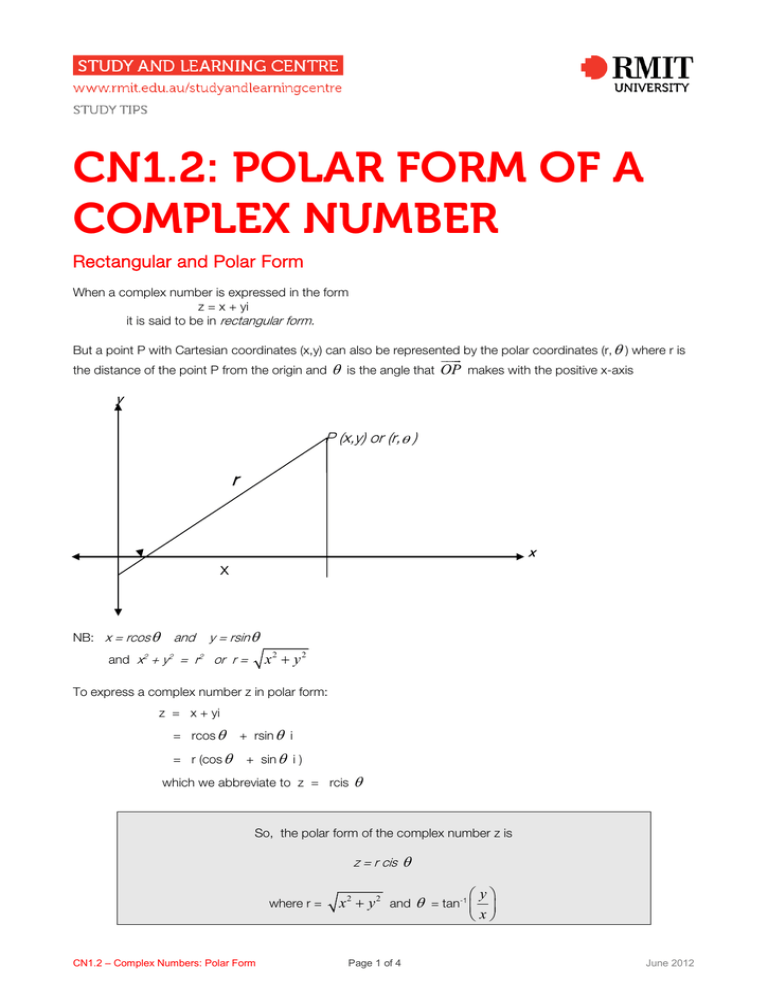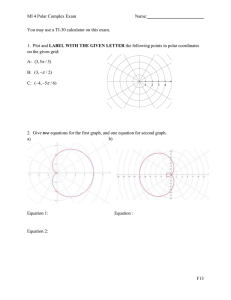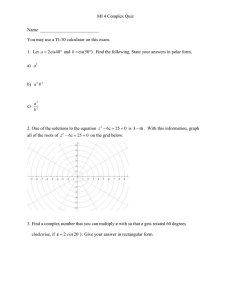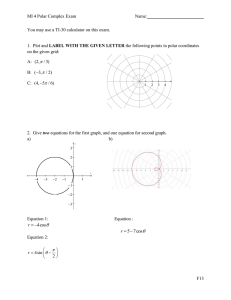CN1.2: POLAR FORM OF A COMPLEX NUMBER
advertisement

CN1.2: POLAR FORM OF A COMPLEX NUMBER Rectangular and Polar Form When a complex number is expressed in the form z = x + yi it is said to be in rectangular form. But a point P with Cartesian coordinates (x,y) can also be represented by the polar coordinates (r, θ ) where r is the distance of the point P from the origin and θ is the angle that OP makes with the positive x-axis y P (x,y) or (r, θ ) r x x NB: x = rcos θ and y = rsin θ x2 + y 2 and x2 + y2 = r2 or r = To express a complex number z in polar form: z = x + yi = rcos θ = r (cos θ + rsin θ i + sin θ i ) which we abbreviate to z = rcis θ So, the polar form of the complex number z is z = r cis where r = CN1.2 – Complex Numbers: Polar Form θ y x 2 + y 2 and θ = tan-1 x Page 1 of 4 June 2012 Modulus of z The modulus of z, z is the distance of the point z from the origin. z = x + yi = mod z = x2 + y 2 = r The argument of z, arg z, is the angle measured from the positive direction of the x-axis to OP If arg z = θ θ then sin = y z and cos θ = x z and tan θ = y x An infinite number of arguments of z exist eg If z = i then arg z = π 2 + 2π n, n ∈ Z . argument and Argument of z We define the Argument of z: Arg z = θ , where −π ≤ θ ≤ π Examples 1. Express in polar form z = 1 – i [NB: z is in the 4th quadrant] x = 1, y = -1 r= z = x2 + y 2 = 1 + 1 = y −1 = -1 = x 1 −π θ = tan-1(-1) = 4 ∴z = rcisθ −π = 2 cis 4 tan θ 2 x ● = 2. Express 2 cis 2 cis y z [since z is in the 4th quadrant] 4π in the form x + yi 3 4π 4π = 2 cos 3 3 = 2 1 × − 2 = -1 - 4π + sin i 3 3 + 2 × − 2 i 3i See Exercise 1 CN1.2 – Complex Numbers: Polar Form Page 2 of 4 June 2012 Operations on Complex Numbers in Polar Form Addition and Subtraction Complex numbers in polar form are best converted to the form x + yi before addition or subtraction Multiplication and Division If z1 = r1cisθ1 and z2 = r2 cisθ 2 then it can be shown using trigonometric identities that z1 r1 z1 z2 = r1r2 cis (θ1 + θ 2 ) and = cis (θ1 − θ 2 ) z2 r2 Examples: 1. If z1 = 2cis 5π find z1 z2 in polar form, −π ≤ θ ≤ π 6 4 π 5π z1 z2 = 2cis × −3cis 4 6 π 5π = -6cis + 4 6 13π = -6cis 12 −11π since −π ≤ θ ≤ π = -6cis 12 π and z2 = -3cis 2. If u = 1 + 3i and v = 2 – i find u in polar form with −π ≤ θ ≤ π v Two approaches are possible: u = 1 + 3i ie. x = 1, y = 3 1 + 3 = 10 3 θ = tan-1 = 1.25R 1 ∴ u = 10 cis1.25, r= v= 2–i 2 ie x = 2, y = -1 22 + ( −1) = 2 r= θ 2 5 −1 R = -0.46 2 = tan-1 ∴v= u Then = v 5 cis0.46R R 10cis1.25 5cis 0.46 R 10 cis(1.25 + 0.46)R 5 = 2 cis 1.71R = OR 1 + 3i u = 2−i v 1 + 3i 2 + i = × 2−i 2+i −1 + 7i = 4 +1 −1 + 7i = 5 1 7 = − + i 5 5 1 7 ∴ x= − , y= 5 5 x 2 + y 2 = (−0.2) 2 + 1.42 = 1.4 tan θ = = -7, θ = 1.71R −0.2 u ∴ = 2 cis(1.71)R v r= 2 See Exercise 2 CN1.2 – Complex Numbers: Polar Form Page 3 of 4 June 2012 Exercises Exercise 1 1. Find the polar form (in radians) of the following complex numbers: (b) z = - 3 + i (d) z = -2 – 4i (a) z = -1 + i (c) z = - 3i 2. Express each of the following complex numbers in rectangular form π (a) 3cis (c) 8cis 7cisπ (b) 4 π (d) 10cis0.41R 2 3. If z = 2 + i and w = 1 – 4i find each of the following in polar form using radians where appropriate: (a) (b) z (e) Arg(zw) (c) Arg z w (d) w (f) zw Exercise 2 1. Simplify (a) 4cis π × 3cis 3 3cis π (b) 4 5π 6 12cis π 6 2. If u = 6cis 3π u π and v = 4cis − express in polar form 4 v 4 3. If z = 1- 3 i, find z and express both z and z in polar form using radians. Answers Exercise 1 1. (a) 2cis 3π (b) 2cis 5π 4 (c) 3cis 6 −π 20cis ( −2.03) (d) R 2 3 2. (a) 3 + 2 i (b) - 7 2 (c) 8i (d) 9.2 + 4i 3. (a) 5 (d) 17 (b) (c) 0.46R 17 (e) -0.86R (f) 9.22cis(-0.86)R Exercise 2 1. (a) 12cis 7π (b) 12 2. (a) 3 1 4 cis 2π 3 cisπ 2 3. π 3 z = 2cis − π z = 2cis 3 CN1.2 – Complex Numbers: Polar Form Page 4 of 4 June 2012




